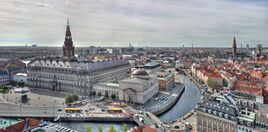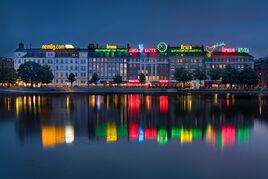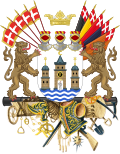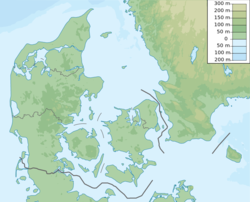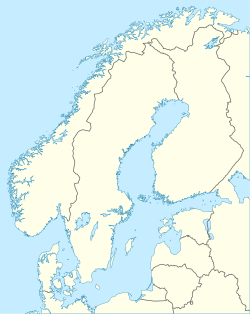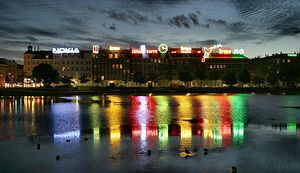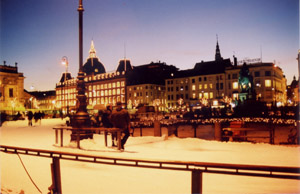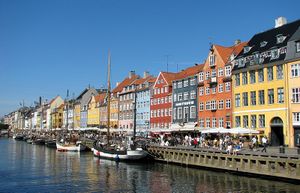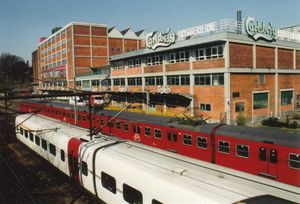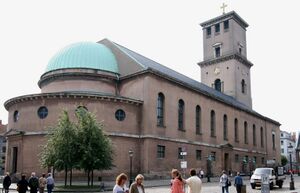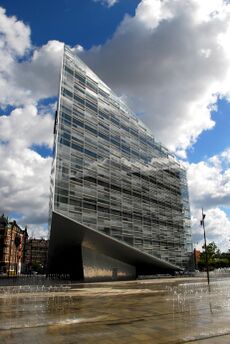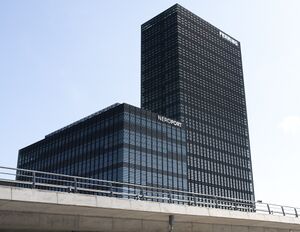كوبنهاغن
كوپنهاگن
Copenhagen København | |
|---|---|
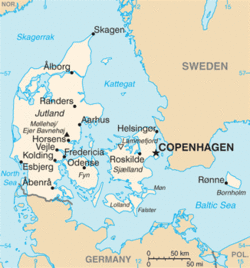 | |
| الإحداثيات: 55°40′34″N 12°34′06″E / 55.67611°N 12.56833°ECoordinates: 55°40′34″N 12°34′06″E / 55.67611°N 12.56833°E | |
| البلد | |
| المنطقة | |
| البلديات | |
| المساحة | |
| • مدينة | 179٫8 كم² (69٫4 ميل²) |
| • الحضر | 292٫5 كم² (112٫9 ميل²) |
| • العمران | 1٬767٫52 كم² (682٫44 ميل²) |
| أعلى منسوب | 91 m (299 ft) |
| أوطى منسوب | 1 m (3 ft) |
| التعداد (1 January 2022)[3] | |
| • مدينة | 805٬420 |
| • الكثافة | 4٬500/km2 (12٬000/sq mi) |
| • Urban | 1٬336٬982 |
| • الكثافة الحضرية | 4٬600/km2 (12٬000/sq mi) |
| • العمرانية | 2٬057٬142 |
| • الكثافة العمرانية | 1٬200/km2 (3٬000/sq mi) |
| صفة المواطن | Copenhagener[4] |
| منطقة التوقيت | UTC+01:00 (CET) |
| • الصيف (التوقيت الصيفي) | UTC+02:00 (CEST) |
| Postal code | 1050–1778, 2100, 2150, 2200, 2300, 2400, 2450, 2500 |
| مفتاح الهاتف | (+45) 3 |
| الموقع الإلكتروني | international |
كوبنهاگن (IPA /ˈkoʊpənheɪɡən/ أو /ˈkoʊpənhɑːɡən/; دنماركية: København [kʰøb̥m̩ˈhɑʊ̯ˀn] (listen ) "كوبن هاون" أي ما معناه باللغة العربية الميناء التجاري) هي عاصمة الدنمارك وأكبر مدنها. يبلغ عدد سكانها 464,566 نسمة، فيما يبلغ عدد سكان المنطقة الحضرية 1,339,395 نسمة. واسمها باللغة الدنماركية هو كوبنهافِن. وتعتبر هذه المدينة الميناء الأساسي للدنمارك والمركز الاقتصادي والسياسي والثقافي الرئيسي. ويسكن ربع سكان الدنمارك في منطقة كوبنهاجن. وتقع بعض أجزاء كوبنهاجن على الشاطئ الشرقي لجزيرة شلاند، بينما تقع الأجزاء الأخرى على جزيرة أماجر شرق شلاند.
تقع ساحة مجلس المدينة في وسط كوبنهاجن. وتتفرع شوارع وطرقات المدينة الرئيسية من الساحة بالإضافة لعدد من طرق الحافلات والقطارات. وتتمركز العديد من المكاتب والفنادق والمتنزهات قرب الساحة كمتنزه الملاهي (حدائق تيڤولي)، وتقدم هذه الحديقة أنواعًا عديدة من ضروب الترويح كركوب الخيل والباليه والحفلات الموسيقية.
يمتد شارع مشجر يسمى سترجيت من ساحة مجلس المدينة إلى ساحة أخرى رئيسية وهي ساحة سوق الملك الجديد. وفى هذا الشارع، المعد للمشاة، العديد من المحلات الكبيرة والأسواق الصغيرة ومقاهي الرصيف. وتقع إلى الشرق من ساحة مجلس المدينة قلعة كريستيانبورگ، وهي مكان وجود البرلمان والمحكمة العليا. ويوجد قرب القلعة مقر الأرشيف القومي والمكتبة الملكية.
وفي مرفأ كوبنهاجن تمثال الحورية الصغيرة وهو مشهور عالميًا؛ ويمثل أحد شخصيات القصص الخيالية التي كتبها المؤلف الدنماركي الشهير هانز كريستيان أندرسن. ومن المعالم الأساسية في المدينة قصر أمالنبرگ ومكتب البورصة ومتحفا كالسبورگ الجديد وثورڤالدسن. وكوبنهاجن موطن دائم لفرقة الباليه الدنماركية الملكية ولجامعة كوبنهاجن وهي أقدم جامعات الدنمارك، وقد أسست في عام 1479.
. . . . . . . . . . . . . . . . . . . . . . . . . . . . . . . . . . . . . . . . . . . . . . . . . . . . . . . . . . . . . . . . . . . . . . . . . . . . . . . . . . . . . . . . . . . . . . . . . . . . . . . . . . . . . . . . . . . . . . . . . . . . . . . . . . . . . . . . . . . . . . . . . . . . . . . . . . . . . . . . . . . . . . . .
بلديات كوبنهاگن
وتعتبر كوبنهاگن أكبر مدينة في الدنمارك. ومع مرور الزمن كبرت البلديات المجاورة لبلدية كوبهاگن وتوحدوا في مدينة واحدة. وتتألف كوبنهاگن من عدة بلديات تسمى جميعها بمنطقة العاصمة. مركز كوبنهاگن العاصمة يدعى كوبنهاگن الكبيرة، وبعض أقسام المدينة التي ترتبط إدارياً مع كوبنهاگن الكبيرة تسمى مجتمعتاً بلدية كوبنهاگن يكون بعد هذا الترابط نفوس سكان بلدية كوبنهاگن فقط حسب البيانات لسنة 2007 قد وصلت 503.699 شخص يسكن هذه المنطقة.
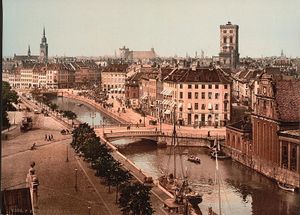
التاريخ
كانت كوبنهاجن في منتصف القرن الحادي عشر قرية صغيرة لصيد الأسماك. ثم أصبحت بسبب مينائها مركزًا تجاريًا، وتطورت لتُصبح بلدة في القرن الثاني عشر الميلادي وأصبحت قضاء قانونيًا عام 1254 وتزايدت أهميتها الاقتصادية خلال بضعة قرون تلت حتى أصبحت عاصمة الدنمارك عام 1443.
ودمرت الحرائق والحروب أجزاء عديدة من كوبنهاجن في فترات عديدة بين عامي 1250 و1810، كما قتلت الأوبئة العديد من سكانها، ولكن كوبنهاجن استطاعت النهوض في كل مرة، واستمرت تنمو كمركز اقتصادي وعسكري وسياسي. وامتدت المدينة نحو الشمال والغرب أثناء القرن التاسع عشر وقد شهدت كوبنهاجن خلال القرن التاسع عشر نموًا سريعًا وبدأت حركة التصنيع؛ كما أنشئ ميناء حر في المدينة عام 1894.
احتلت القوات الألمانية كوپنهاگن منذ عام 1940 وحتى عام 1945 خلال الحرب العالمية الثانية. ولكنها لم تسبب للمدينة إلا القليل من الأضرار.
كوبنهاگن في المستقبل
الموقع
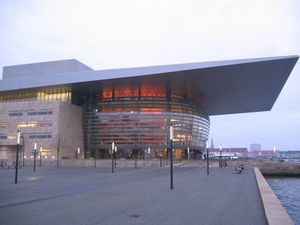
الأقاليم والمناطق
تتكون كوبنهاجن من عدد من الأقاليم والمنطاق وهي:
- Østerbro
- Nørrebro
- Vesterbro
- Amagerbro
- Nordhavnen (North Habour)
- Valby
- Kongens Enghave (King's Meadow Garden), also known as Sydhavnen (meaning South Harbour)
- Christianshavn
- Christiania
- Sundbyvester (Sundby West),
- Sundbyøster (Sundby East)
- Ørestad
- Islands Brygge
- Bellahøj
- Brønshøj
- Ryparken
- Bispebjerg
- Vigerslev
- Vestamager
- Vanløse
الضواحي الخارجية
الضواحي الشمالية
- Lyngby
- Klampenborg
- Hørsholm
- Søllerød
- Brede
- Gentofte
- Charlottenlund
- Virum
- Sorgenfri
- Nærum
- Vedbæk
- Tårbæk
- Skodsborg
- Holte
- Birkerød
الضواحي الشمالية الغربية
- Værløse
- Farum
- Bagsværd
- Buddinge
- Tingbjerg
- Mørkhøj
- Søborg
- Vangede
- Gladsaxe
- Høje-Gladsaxe (Gladsaxe Heights)
- Hareskovby
الضواحي الغربية
- Herlev
- Ballerup
- Skovlunde
- Smørum
- Islev
- Måløv
- Rødovre
- Glostrup
- Brøndby
- Hvessinge
- Albertslund
- Taastrup
- Høje-Taastrup (Taastrup Heights)
- Hedehusene
ضواحي جزيرة Amager
السكان
Population by ethnic background in 2022
| Nationals by sub-national origin (Q1 2006)[6] | |
|---|---|
| الجنسية | التعداد |
| 5,333 | |
| Immigrants by country of origin (Top 15) (Q1 2022)[7] | |||||||||||||||||||||||||||||||||||||||||||||||||||||||||||
|---|---|---|---|---|---|---|---|---|---|---|---|---|---|---|---|---|---|---|---|---|---|---|---|---|---|---|---|---|---|---|---|---|---|---|---|---|---|---|---|---|---|---|---|---|---|---|---|---|---|---|---|---|---|---|---|---|---|---|---|
| العرقية | التعداد | ||||||||||||||||||||||||||||||||||||||||||||||||||||||||||
| 8,581 | |||||||||||||||||||||||||||||||||||||||||||||||||||||||||||
| 7,457 | |||||||||||||||||||||||||||||||||||||||||||||||||||||||||||
| 6,894 | |||||||||||||||||||||||||||||||||||||||||||||||||||||||||||
| 6,720 | |||||||||||||||||||||||||||||||||||||||||||||||||||||||||||
| 6,510 | |||||||||||||||||||||||||||||||||||||||||||||||||||||||||||
| 5,459 | |||||||||||||||||||||||||||||||||||||||||||||||||||||||||||
| 5,440 | |||||||||||||||||||||||||||||||||||||||||||||||||||||||||||
| 5,312 | |||||||||||||||||||||||||||||||||||||||||||||||||||||||||||
| 5,263 | |||||||||||||||||||||||||||||||||||||||||||||||||||||||||||
| 5,058 | |||||||||||||||||||||||||||||||||||||||||||||||||||||||||||
| 4,787 | |||||||||||||||||||||||||||||||||||||||||||||||||||||||||||
| 4,752 | |||||||||||||||||||||||||||||||||||||||||||||||||||||||||||
| 4,295 | |||||||||||||||||||||||||||||||||||||||||||||||||||||||||||
| 4,243 | |||||||||||||||||||||||||||||||||||||||||||||||||||||||||||
| 4,232 | |||||||||||||||||||||||||||||||||||||||||||||||||||||||||||
| |||||||||||||||||||||||||||||||||||||||||||||||||||||||||||
Copenhagen is the most populous city in Denmark and one of the most populous in the Nordic countries. For statistical purposes, Statistics Denmark considers the City of Copenhagen (Byen København) to consist of the Municipality of Copenhagen plus three adjacent municipalities: Dragør, Frederiksberg, and Tårnby.[8] Their combined population stands at 763,908 (اعتبارا من ديسمبر 2016[تحديث]).[9]
The Municipality of Copenhagen is by far the most populous in the country and one of the most populous Nordic municipalities with 644,431 inhabitants (as of 2022).[4] There was a demographic boom in the 1990s and first decades of the 21st century, largely due to immigration to Denmark. According to figures from the first quarter of 2022, 73.7% of the municipality's population was of Danish descent,[7] defined as having at least one parent who was born in Denmark and has Danish citizenship. Much of the remaining 26.3% were of a foreign background, defined as immigrants (20.3%) or descendants of recent immigrants (6%).[7] There are no official statistics on ethnic groups. The adjacent table shows the most common countries of origin of Copenhagen residents. Largest foreign groups are Pakistanis (1.3%), Turks (1.2%), Iraqis (1.1%), Germans (1.0%) and Poles (1.0%).
According to Statistics Denmark, Copenhagen's urban area has a larger population of 1,280,371 (اعتبارا من 1 يناير 2016[تحديث]).[4] The urban area consists of the municipalities of Copenhagen and Frederiksberg plus 16 of the 20 municipalities of the former counties Copenhagen and Roskilde, though five of them only partially.[10] Metropolitan Copenhagen has a total of 2,016,285 inhabitants (اعتبارا من 2016[تحديث]).[4] The area of Metropolitan Copenhagen is defined by the Finger Plan.[11] Since the opening of the Øresund Bridge in 2000, commuting between Zealand and Scania in Sweden has increased rapidly, leading to a wider, integrated area. Known as the Øresund Region, it has 4.1 million inhabitants (of whom 2.7 million (August 2021) live in the Danish part of the region).[12]
. . . . . . . . . . . . . . . . . . . . . . . . . . . . . . . . . . . . . . . . . . . . . . . . . . . . . . . . . . . . . . . . . . . . . . . . . . . . . . . . . . . . . . . . . . . . . . . . . . . . . . . . . . . . . . . . . . . . . . . . . . . . . . . . . . . . . . . . . . . . . . . . . . . . . . . . . . . . . . . . . . . . . . . .
الدين
A majority (56.9%) of those living in Copenhagen are members of the Lutheran Church of Denmark which is 0.6% lower than one year earlier according to 2019 figures.[13] The National Cathedral, the Church of Our Lady, is one of the dozens of churches in Copenhagen. There are also several other Christian communities in the city, of which the largest is Roman Catholic.[14]
Foreign migration to Copenhagen, rising over the last three decades, has contributed to increasing religious diversity; the Grand Mosque of Copenhagen, the first in Denmark, opened in 2014.[15] Islam is the second largest religion in Copenhagen, accounting for approximately 10% of the population.[16][17][18] While there are no official statistics, a significant portion of the estimated 175,000–200,000 Muslims in the country live in the Copenhagen urban area, with the highest concentration in Nørrebro and the Vestegnen.[19] There are also some 7,000 Jews in Denmark, most of them in the Copenhagen area where there are several synagogues.[20] There is a long history of Jews in the city, and the first synagogue in Copenhagen was built in 1684.[21] Today, the history of the Jews of Denmark can be explored at the Danish Jewish Museum in Copenhagen.
جودة الحياة
For a number of years, Copenhagen has ranked high in international surveys for its quality of life. Its stable economy together with its education services and level of social safety make it attractive for locals and visitors alike. Although it is one of the world's most expensive cities, it is also one of the most liveable with its public transport, facilities for cyclists and its environmental policies.[22] In elevating Copenhagen to "most liveable city" in 2013, Monocle pointed to its open spaces, increasing activity on the streets, city planning in favour of cyclists and pedestrians, and features to encourage inhabitants to enjoy city life with an emphasis on community, culture and cuisine.[23] Other sources have ranked Copenhagen high for its business environment, accessibility, restaurants and environmental planning.[24] However, Copenhagen ranks only 39th for student friendliness in 2012. Despite a top score for quality of living, its scores were low for employer activity and affordability.[25]
الاقتصاد
Copenhagen is the major economic and financial centre of Denmark. The city's economy is based largely on services and commerce. Statistics for 2010 show that the vast majority of the 350,000 workers in Copenhagen are employed in the service sector, especially transport and communications, trade, and finance, while less than 10,000 work in the manufacturing industries. The public sector workforce is around 110,000, including education and healthcare.[26] From 2006 to 2011, the economy grew by 2.5% in Copenhagen, while it fell by some 4% in the rest of Denmark.[27] In 2017, the wider Capital Region of Denmark had a gross domestic product (GDP) of €120 billion, and the 15th largest GDP per capita of regions in the European Union.[28]
Several financial institutions and banks have headquarters in Copenhagen, including Alm. Brand, Danske Bank, Nykredit and Nordea Bank Danmark. The Copenhagen Stock Exchange (CSE) was founded in 1620 and is now owned by Nasdaq, Inc. Copenhagen is also home to a number of international companies including A.P. Møller-Mærsk, Novo Nordisk, Carlsberg and Novozymes.[29] City authorities have encouraged the development of business clusters in several innovative sectors, which include information technology, biotechnology, pharmaceuticals, clean technology and smart city solutions.[30][31]
Life science is a key sector with extensive research and development activities. Medicon Valley is a leading bi-national life sciences cluster in Europe, spanning the Øresund Region. Copenhagen is rich in companies and institutions with a focus on research and development within the field of biotechnology,[32] and the Medicon Valley initiative aims to strengthen this position and to promote cooperation between companies and academia. Many major Danish companies like Novo Nordisk and Lundbeck, both of which are among the 50 largest pharmaceutical and biotech companies in the world, are located in this business cluster.[33]
Shipping is another import sector with Maersk, the world's largest shipping company, having their world headquarters in Copenhagen. The city has an industrial harbour, Copenhagen Port. Following decades of stagnation, it has experienced a resurgence since 1990 following a merger with Malmö harbour. Both ports are operated by Copenhagen Malmö Port (CMP). The central location in the Øresund Region allows the ports to act as a hub for freight that is transported onward to the Baltic countries. CMP annually receives about 8,000 ships and handled some 148,000 TEU in 2012.[34]
Copenhagen has some of the highest gross wages in the world.[35] High taxes mean that wages are reduced after mandatory deduction. A beneficial researcher scheme with low taxation of foreign specialists has made Denmark an attractive location for foreign labour. It is however also among the most expensive cities in Europe.[36][37]
Denmark's Flexicurity model features some of the most flexible hiring and firing legislation in Europe, providing attractive conditions for foreign investment and international companies looking to locate in Copenhagen.[38] In Dansk Industri's 2013 survey of employment factors in the ninety-six municipalities of Denmark, Copenhagen came in first place for educational qualifications and for the development of private companies in recent years, but fell to 86th place in local companies' assessment of the employment climate. The survey revealed considerable dissatisfaction in the level of dialogue companies enjoyed with the municipal authorities.[39]
السياحة
Tourism is a major contributor to Copenhagen's economy, attracting visitors due to the city's harbour, cultural attractions and award-winning restaurants. Since 2009, Copenhagen has been one of the fastest growing metropolitan destinations in Europe.[40] Hotel capacity in the city is growing significantly. From 2009 to 2013, it experienced a 42% growth in international bed nights (total number of nights spent by tourists), tallying a rise of nearly 70% for Chinese visitors.[40] The total number of bed nights in the Capital Region surpassed 9 million in 2013, while international bed nights reached 5 million.[40]
In 2010, it is estimated that city break tourism contributed to DKK 2 billion in turnover. However, 2010 was an exceptional year for city break tourism and turnover increased with 29% in that one year.[41] 680,000 cruise passengers visited the port in 2015.[42] In 2019 Copenhagen was ranked first among Lonely Planet's top ten cities to visit.[43] In October 2021, Copenhagen was shortlisted for the European Commission's 2022 European Capital of Smart Tourism award along with Bordeaux, Dublin, Florence, Ljubljana, La Palma de Mallorca and Valencia.[44]
الثقافة والإبداع
الموسيقى والترفيه
الرياضة
. . . . . . . . . . . . . . . . . . . . . . . . . . . . . . . . . . . . . . . . . . . . . . . . . . . . . . . . . . . . . . . . . . . . . . . . . . . . . . . . . . . . . . . . . . . . . . . . . . . . . . . . . . . . . . . . . . . . . . . . . . . . . . . . . . . . . . . . . . . . . . . . . . . . . . . . . . . . . . . . . . . . . . . .
الطعام
الطبيعة
الإقتصاد
تعتبر كوبنهاجن المركز التجاري والصناعي للدنمارك ومن منتجاتها: محركات الديزل والمفروشات والخزف الصيني. وتعتبر التجارة مهمة أيضًا لاقتصاد كوبنهاجن. وتشكل الحافلات وقطارات نقل الركاب غالبية وسائل النقل العام في كوبنهاجن. كما يركب العديد من الناس الدراجات الهوائية، حيث توجد ممرات خاصة بالدراجات في معظم الشوارع الرئيسية ويوجد مطار دولي في جنوب شرق المدينة.
التعليم والبحث العلمي
النقل
الطرق
الدراجات
الميناء
المطارات
النقل العام
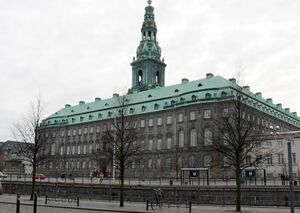 Christiansborg Palace - home of the Danish Parliament Folketinget, the Supreme Court, Office of the Prime Minister and official reception area of Queen Margrethe II |
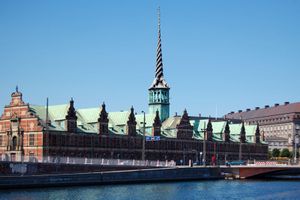 Børsen - the former Stock Exchange building |
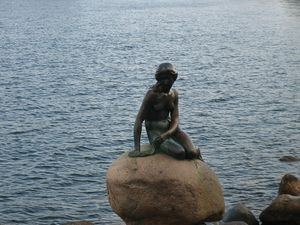 The Little Mermaid statue in Copenhagen harbor |
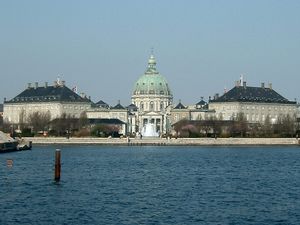 Amalienborg Palace - home of the Danish royal family. The central building is the domed Marble Church located behind the palace complex |
مدن شقيقة
كوبنهاجن متوأمة مع:
قراءات إضافية
- Municipal statistics: NetBorger Kommunefakta, delivered from KMD, also known as Kommunedata (Municipal Data)
- Municipal and county statistics: Statistics Denmark statistikbanken.dk
- Demography: (دنماركية) Statistical Yearbook of Copenhagen (part English); ISBN 87-7024-230-5
- History and demography: (دنماركية) København Forslag til kommuneplan 1985; ISBN 87-88034-03-8
انظر أيضا
- Oresund Region
- Eurovision Song Contest 2001
- Junior Eurovision Song Contest 2003
- MTV Europe Music Awards 2006
- Transportation in Denmark
- Ports of the Baltic Sea
ملاحظات
المصادر
- ويكيبديا الدنماريكية
- ^ "ARE207: Area by region". Statbank.dk. Statistics Denmark. January 2016. Archived from the original on 4 March 2016. Retrieved 16 April 2016.
- ^ "Statistics Denmark: Copenhagen City/Urban Area (Københavns Kommune, Hovedstadsområdet), 2012 (tables: FOLK1, BEF44)". Statistics Denmark. Archived from the original on 6 January 2021. Retrieved 31 May 2012.
- ^ "StatBank Denmark – data and statistics". Statistics Denmark. Archived from the original on 5 December 2020. Retrieved 2018-02-10.
- ^ أ ب ت ث "Population at the first day of the quarter by urban areas, age and sex". statbank.dk. Statistics Denmark. 1 January 2016. Archived from the original on 25 February 2021. Retrieved 18 April 2016.
- ^ "Archived copy". Archived from the original on 2 April 2017. Retrieved 6 August 2017.
{{cite web}}: CS1 maint: archived copy as title (link) - ^ "Grønlænderebosiddende i Danmark" (PDF). The North Atlantic Group in the Danish Parliament. 1 January 2006. Archived (PDF) from the original on 30 October 2020. Retrieved 3 October 2020.
- ^ أ ب ت "Population and Elections (See: POPULATION AT THE FIRST DAY OF THE QUARTER BY REGION, SEX, AGE (5 YEARS AGE GROUPS), ANCESTRY AND COUNTRY OF ORIGIN)". Statistics Denmark. 22 April 2022. Retrieved 22 April 2022.
- ^ خطأ استشهاد: وسم
<ref>غير صحيح؛ لا نص تم توفيره للمراجع المسماةdst.dk - ^ خطأ استشهاد: وسم
<ref>غير صحيح؛ لا نص تم توفيره للمراجع المسماةReferenceA - ^ خطأ استشهاد: وسم
<ref>غير صحيح؛ لا نص تم توفيره للمراجع المسماةurban - ^ "The Finger Plan: A Strategy for the Development of the Greater Copenhagen Area" (PDF). Danish Ministry of the Environment. Archived (PDF) from the original on 4 August 2016. Retrieved 22 April 2016.
- ^ "Befolkning: Befolkningsvækst" (in الدانمركية). ÖresundsStatistik och analyser. Archived from the original on 4 January 2014. Retrieved 6 December 2013.
- ^ "Folkekirkens medlemstal" (in الدانمركية). Kirkeministeriet. Archived from the original on 13 April 2016. Retrieved 3 June 2019.
- ^ "Nøgletal for sognene" (PDF). Katolsk.dk. Archived (PDF) from the original on 26 September 2013. Retrieved 26 November 2013.
- ^ Hooper, Simon (22 June 2014). "Denmark's first mosque opens amid controversy". Al Jazeera. Archived from the original on 28 April 2016. Retrieved 15 April 2016.
- ^ Nydell, Margaret K. (23 March 2012). Understanding Arabs: a contemporary guide to Arab society. Boston, MA: Intercultural Press. p. 132. ISBN 978-0-9839558-0-1.
In 2011 they constituted 25 percent of Rotterdam, Marseilles, and Amsterdam; 20% of Malmö; 15 percent of Brussels and Birmingham; and 10 percent of London, Paris, Copenhagen, and Vienna.
Muslims in Western Europe originate from both Arab and non-Arab countries. Those in the United Kingdom are primarily from South Asia, in France from North and West Africa, in Germany from Turkey, in Belgium from Morocco, and in the Netherlands from Morocco and Turkey. - ^ Farmer, Brian R. (2010). Radical Islam in the West: ideology and challenge. Jefferson, N.C.: McFarland & Co. p. 8. ISBN 978-0-7864-5953-7.
Muslims living in the West are also concentrated in urban area. Muslims are currently estimated to compose almost one-fourth of the population of Amsterdam. one-fifth of Marseilles, and 15 percent of Paris, Brussels, and Birmingham. Muslims are currently make up approximately 10 percent of the populations in London and Copenhagen.
- ^ Micklethwait, John; Wooldridge, Adrian (2009). God is back how the global revival of faith is changing the world. New York: Penguin Press. ISBN 978-1-101-03241-1.
Muslims are highly concentrated—they make up 24 percent of the population in Amsterdam; 20 percent in Malmö and Marseille; 15 percent in Paris, Brussels, Bradford, and Birmingham; and 10 percent or more in London and Copenhagen.
- ^ Muslimer i København (PDF) (in الدانمركية). Open Society Foundations. 2011. pp. 24, 33–38. ISBN 978-1-936133-10-9. Archived (PDF) from the original on 2 December 2013. Retrieved 26 November 2013.
- ^ "Jødedom i Danmark" (in الدانمركية). Religion-dk. Archived from the original on 15 October 2013. Retrieved 26 November 2013.
- ^ "The Jewish Community of Copenhagen". The Museum of the Jewish People at Beit Hatfutsot. Archived from the original on 17 June 2018. Retrieved 17 June 2018.
- ^ Flint, Sunshine (September 2011). "Living in Copenhagen". BBC. Archived from the original on 29 November 2013. Retrieved 30 November 2013.
- ^ "Most liveable city: Copenhagen". Monocle. Archived from the original on 3 December 2013. Retrieved 30 November 2013.
- ^ "Prestigious titles and rankings to Copenhagen". Visit Copenhagen. 6 September 2013. Archived from the original on 3 December 2013. Retrieved 30 November 2013.
- ^ Chebotareva, Polina (15 February 2012). "Copenhagen is high quality of life, but at a price". University Post. Archived from the original on 3 December 2013. Retrieved 30 November 2013.
- ^ "Workplaces in Copenhagen by industry and residence of the employed, 1 January 2010". City of Copenhagen. Archived from the original on 2 December 2013. Retrieved 25 November 2013.
- ^ "Udvalgte indikatorer for Københavns erhvervsmæssige præstationer og rammevilkår" (PDF) (in الدانمركية). DAMVAD. 14 November 2013. Archived from the original (PDF) on 3 December 2013. Retrieved 26 November 2013.
- ^ "Regional GDP per capita in the EU in 2010" (PDF). Eurostat. 21 March 2013. Archived from the original (PDF) on 3 April 2013. Retrieved 14 April 2016.
- ^ "The World's Biggest Public Companies". Forbes. 18 April 2012. Archived from the original on 27 March 2013. Retrieved 18 November 2013.
- ^ "Copenhagen – Open for Business" (in الدانمركية). New European Economy. Archived from the original on 18 November 2013. Retrieved 18 November 2013.
- ^ "Turning Denmark into a leader in Smart Cities". arup.com. Arup Group. 28 January 2016. Archived from the original on 15 April 2016. Retrieved 16 April 2016.
- ^ "Life Science in the Øresund Region". Copenhagen Capacity. Archived from the original on 12 January 2014. Retrieved 23 January 2014.
- ^ "Copenhagen – Overview". USA Today. 19 May 2009. Archived from the original on 11 May 2012. Retrieved 9 March 2013.
- ^ "Copenhagen Malmö Port Annual Report 2012". Copenhagen Malmö Port. Archived from the original (PDF) on 17 October 2016. Retrieved 15 April 2016.
- ^ "World's richest cities". City Mayors. Archived from the original on 25 August 2011. Retrieved 5 May 2009.
- ^ "World's most expensive cities (EIU)". City Mayors. Archived from the original on 16 March 2010. Retrieved 5 May 2009.
- ^ "World's most expensive cities – Ranking". City Mayors. Archived from the original on 17 March 2011. Retrieved 5 May 2009.
- ^ "Reasons to invest in Greater Copenhagen". Copenhagen Capacity. Archived from the original on 10 April 2016. Retrieved 13 April 2016.
- ^ "Pressemeddelelse: Københavns virksomheder efterlyser bedre erhvervsklima" (in الدانمركية). Dansk Industri. 4 September 2013. Archived from the original on 10 December 2013. Retrieved 18 November 2013.
- ^ أ ب ت "Copenhagen – a city of growth". Wonderful Copenhagen / Global Connected. Archived from the original on 6 May 2016. Retrieved 15 April 2016.
- ^ "Copenhagen City Break Strategy 2012–2014" (PDF). VisitDenmark / Wonderful Copenhagen. Archived from the original (PDF) on 24 April 2016. Retrieved 15 April 2016.
- ^ "Press room". Cruise Copenhagen Network. Archived from the original on 6 May 2016. Retrieved 15 April 2016.
- ^ Hetter, Katia (22 October 2018). "Lonely Planet's top 10 cities to visit in 2019". CNN. Archived from the original on 17 December 2018. Retrieved 17 December 2018.
- ^ "2022 European Capital of Smart Tourism nomination cities". Daily Home List. Retrieved 15 October 2021.
- ^ "Sister Cities". beijing.gov.cn. Beijing. Archived from the original on 4 March 2021. Retrieved 14 April 2021.
- ^ "Marseille open on the world". marseille.fr (in الفرنسية). Marseille. Archived from the original on 15 April 2021. Retrieved 14 April 2021.
- ^ "Twin Cities Reykjavik".
- ^ "København vedtager venskabsaftale med Kyiv".
وصلات خارجية
- Wonderful Copenhagen official tourism web site
- Copenhagen Capacity official investment agency of Copenhagen
- كوبنهاغن travel guide from Wikitravel
- Official Municipal Website
- City of Copenhagen Statistical Office
- Krak searchable map(outline of municipality visible online but doesn't print out!)
- CS1 الدانمركية-language sources (da)
- CS1 الفرنسية-language sources (fr)
- Short description is different from Wikidata
- Missing redirects
- Pages using multiple image with auto scaled images
- Coordinates on Wikidata
- Articles containing دنماركية-language text
- Articles with hatnote templates targeting a nonexistent page
- مقالات فيها عبارات متقادمة منذ ديسمبر 2016
- جميع المقالات التي فيها عبارات متقادمة
- مقالات فيها عبارات متقادمة منذ يناير 2016
- مقالات فيها عبارات متقادمة منذ 2016
- Municipal seats in Capital Region of Denmark
- مقار بلديات الدنمارك
- موانئ بحر البلطيق
- مدن الدانمارك
- عواصم أوروبا
- أماكن مأهولة تأسست في القرن 11
- Busking venues
- عواصم أوربا
- كوبنهاگن
- موانئ الدنمارك

